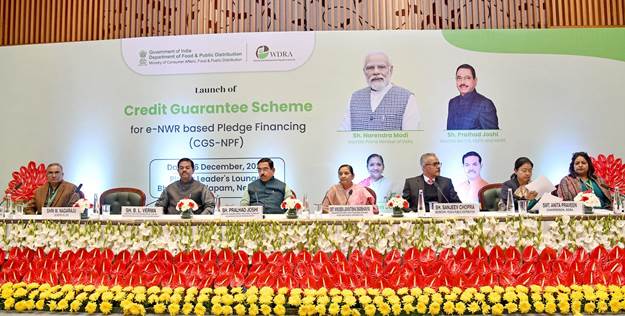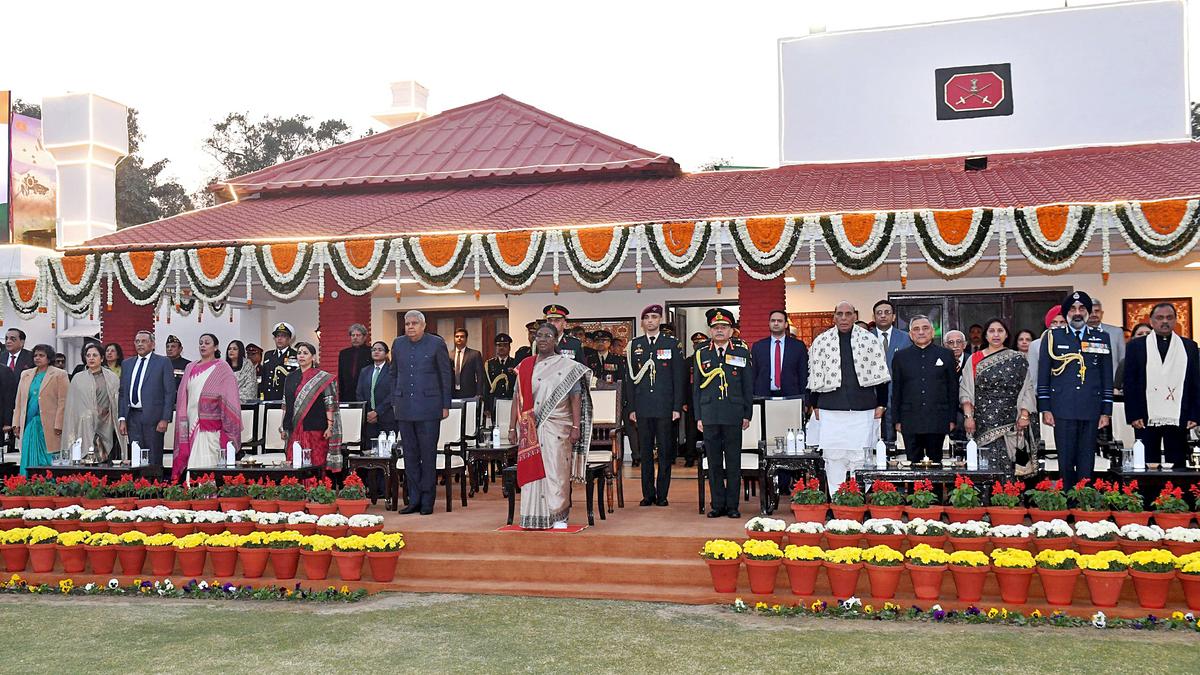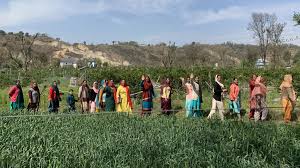Credit Guarantee Scheme for e-NWR based Pledge Financing (CGS-NPF)

- 17 Dec 2024
In News:
The Credit Guarantee Scheme for e-NWR based Pledge Financing (CGS-NPF), launched by Union Minister Pralhad Joshi aims to support farmers by facilitating post-harvest finance using electronic negotiable warehouse receipts (e-NWRs). This initiative is part of the government’s efforts to minimize distress selling and ensure financial security for farmers, particularly small and marginalized ones.
Key Features of the Scheme:
- Total Corpus: ?1,000 crore for post-harvest finance.
- Loan Coverage:
- Agricultural purposes: Loans up to ?75 lakh.
- Non-agricultural purposes: Loans up to ?200 lakh.
- Eligible Borrowers: Small and marginal farmers, women, SC/ST/PwD farmers, MSMEs, traders, Farmer Producer Organizations (FPOs), and farmer cooperatives.
- Eligible Institutions: All scheduled and cooperative banks.
- Guarantee Coverage:
- Small and marginal farmers/Women/SC/ST/PwD: 85% for loans up to ?3 lakh, and 80% for loans between ?3 lakh to ?75 lakh.
- Other borrowers: 75% coverage for loans up to ?200 lakh.
- Risks Covered: Both credit risk and warehouseman risk.
- Guarantee Fees: 0.4% per annum for farmers, and 1% per annum for non-farmers.
Objectives:
- Minimize distress selling: By providing easy access to loans post-harvest, the scheme helps farmers avoid selling produce at low prices due to cash crunches.
- Instill confidence in banks: The scheme provides a guarantee cover to lenders, encouraging them to offer loans against e-NWRs.
- Encourage warehouse registration: The scheme emphasizes the need for more warehouses, particularly those closer to farmland, to improve accessibility for farmers.
About e-NWRs:
- e-NWRs are digital versions of traditional warehouse receipts that enable farmers to pledge stored commodities as collateral for loans.
- These receipts are governed by the Warehousing (Development and Regulation) Act of 2007, and since 2017, e-NWRs have been mandated for use in transactions related to agricultural produce stored in WDRA-accredited warehouses.
Expected Impact:
- This scheme is expected to boost post-harvest lending, with a target of increasing lending to ?5.5 lakh crore in the next decade.
- It will improve farmers’ income, reduce dependence on informal credit sources, and foster better financial inclusion.
- Additionally, it will create a more reliable supply chain for agricultural produce, enhancing food security.
Future Targets:
- Increase the number of registered warehouses under the WDRA to 40,000 in the next 1–2 years.
- Use platforms like e-Kisan Upaj Nidhi to streamline the lending process and avoid repeated visits to banks.
Vijay Diwas 2024

- 17 Dec 2024
In News:
On December 16, 2024, India commemorated Vijay Diwas, marking the 53rd anniversary of its victory in the 1971 Bangladesh Liberation War. This day honors the bravery and sacrifices of Indian soldiers and the Mukti Bahini, whose collective efforts led to the creation of Bangladesh as an independent nation. On this occasion, leaders across India, paid heartfelt tributes to the fallen heroes who contributed to the victory, and to the enduring India-Bangladesh friendship.
The 1971 Bangladesh Liberation War culminated in the surrender of over 90,000 Pakistani soldiers, and India’s victory is celebrated as a defining moment in South Asian history.
The War’s Historical Context:
The 1971 Bangladesh Liberation War was a pivotal conflict between East Pakistan (now Bangladesh) and West Pakistan (now Pakistan), leading to Bangladesh’s independence. It was a direct result of decades of social, political, and economic discrimination faced by East Pakistan, despite its larger population and contribution to Pakistan’s economy. Major events leading to the war included:
- Cultural and linguistic marginalization, with East Pakistan's Bengali language and identity being suppressed by the West.
- The 1970 elections that saw the Awami League, led by Sheikh Mujibur Rahman, win a decisive victory in East Pakistan, but their demand for greater autonomy was rejected by West Pakistan.
- The violent crackdown by the Pakistani military in Operation Searchlight in March 1971, leading to widespread atrocities and a mass exodus of refugees into India.
India’s Role in the War:
India’s involvement in the conflict was initially cautious, but the refugee crisis—with over 10 million people fleeing to India—forced India to take action. India provided humanitarian aid and supported the Mukti Bahini, a guerrilla force of Bangladeshi fighters. On December 3, 1971, Pakistan’s preemptive airstrike on Indian military bases led to India's retaliation and full-scale military involvement, including air and naval operations.
India’s military, with assistance from the Mukti Bahini, launched a decisive campaign, ultimately leading to Pakistan’s surrender on December 16, 1971, and the creation of Bangladesh.
Vijay Diwas Observances:
- The 53rd Vijay Diwas celebrations at Fort William, Kolkata, saw a Bangladeshi delegation—including Mukti Joddhas (freedom fighters)—reflect on their memories of the war, highlighting India's crucial role in the liberation of Bangladesh.
- The event also featured a wreath-laying ceremony, military tattoo, and a salute to the shared sacrifice and friendship between India and Bangladesh.
The 1971 Surrender Painting and New Symbolism:
In an interesting development, the iconic 1971 surrender painting, depicting the surrender of Pakistani forces in Dhaka, was moved from the Army Chief’s lounge to the Manekshaw Centre. The painting was replaced by Karam Kshetra–Field of Deeds, a new artwork symbolizing India’s strategic and cultural heritage. This new piece incorporates elements like Lord Krishna’s chariot, Chanakya, and modern military assets, reflecting India’s military prowess and heritage.
Atmanirbhar Clean Plant Programme

- 17 Dec 2024
In News:
Recently, the Government of India and the Asian Development Bank (ADB) signed a $98 million loan agreement to enhance horticulture crop productivity by improving plant health management. This initiative is part of India’s Atmanirbhar Clean Plant Programme (CPP), aiming to provide farmers with access to certified disease-free planting materials to improve yields, quality, and resilience, particularly against climate change impacts.
Key Highlights of the Loan Agreement
- Objective: Improve access to certified, disease-free planting materials for horticulture crops.
- Implementation: The project will be implemented by the Ministry of Agriculture and Farmers Welfare through the National Horticulture Board (NHB) and the Indian Council of Agricultural Research (ICAR).
- Focus: The initiative will enhance farmers’ productivity, resilience to climate change, and pest/disease management through the Atmanirbhar Clean Plant Programme (CPP).
About the Atmanirbhar Clean Plant Programme (CPP)
The Atmanirbhar Clean Plant Programme aims to tackle critical challenges in horticulture by ensuring farmers have access to high-quality, virus-free planting materials. The program is designed to:
- Enhance crop yields and quality.
- Promote climate-resilient varieties to help farmers adapt to rising temperatures and extreme weather events.
- Safeguard the environment by controlling plant diseases and pests proactively.
Key Components of the CPP
- Clean Plant Centers (CPCs): Establishment of nine world-class CPCs across India, equipped with advanced diagnostic labs and tissue culture facilities to maintain disease-free foundation planting materials.
- Certification Framework: A robust certification system will be introduced to ensure accountability in planting material production, including accreditation for private nurseries.
- Climate Resilience: Focus on developing and disseminating climate-resilient plant varieties, addressing the growing concerns over extreme weather events and changing pest behavior due to climate change.
Significance of the Loan Agreement
- Climate Adaptation: The project will help farmers mitigate the effects of climate change, including unpredictable weather patterns and altered pest/disease behaviors.
- Economic Impact: The initiative aligns with India's vision of self-reliance in horticulture (Atmanirbhar Bharat), boosting agricultural productivity and sustainability.
- Long-term Benefits: Improved farm productivity, sustainability, and economic well-being for farmers, especially in the face of climate change.
Global Horticulture Significance
- India’s Position: India is the second-largest producer of fruits and vegetables globally, contributing 33% to the agricultural GDP.
- Land Coverage: Horticulture occupies 18% of India’s agricultural land, yet its production surpasses that of food grains.
Implementation and Impact
- Implementation Period: The project will be executed from 2024 to 2030, with 50% financial assistance from ADB.
- Institutional Strengthening: The initiative will bolster India’s ability to manage plant health, integrating advanced diagnostic techniques and capacity-building for horticulture professionals.
Exercise Agni Warrior

- 17 Dec 2024
In News:
The 13th edition of Exercise Agni Warrior (XAW-2024), a joint military drill between the Indian Army and the Singapore Armed Forces (SAF), concluded successfully at the Field Firing Ranges, Devlali, Maharashtra. The exercise focused on enhancing mutual understanding and interoperability between the two nations’ artillery units.
Key Facts:
- Participating Nations: India and Singapore
- Location: Field Firing Ranges, Devlali, Maharashtra
- Participants:
- 182 personnel from the Singapore Artillery
- 114 personnel from the Indian Army's Regiment of Artillery
- Objective: To maximize mutual understanding of drills and procedures for joint operations under the UN Charter, particularly in firepower planning and execution, utilizing advanced artillery technologies.
- Historical Context: The exercise began in 2004 under a bilateral agreement between India and Singapore and has evolved over the years, now marking 20 years of cooperation.
Purpose and Highlights:
The exercise aimed to reinforce the long-standing defense relationship between India and Singapore, focusing on:
- Joint Firepower Planning and Execution: Both forces demonstrated the use of New Generation Artillery Equipment, enhancing their firepower coordination.
- Enhancing Interoperability: The exercise emphasized seamless coordination between the two armies to operate as a multinational force under the UN Charter, addressing global security challenges.
- Knowledge Sharing: Personnel from both armies exchanged expertise on advanced artillery tactics, fostering a deeper understanding of each other's military capabilities.
- Technological Integration: Both sides integrated cutting-edge technologies, allowing the exchange of best practices in the use of artillery systems.
Key Objectives of XAW-2024:
- Enhanced Interoperability: To ensure smooth coordination in joint operations, fostering the ability to respond to regional security threats.
- Firepower and Coordination Techniques: Sharing expertise on artillery planning, coordination, and execution.
- Advanced Equipment Use: Testing and demonstrating modern artillery systems in joint operations, ensuring both forces are prepared for contemporary warfare.
Structure and Execution:
The exercise was structured to include pre-exercise training, field operations, and a post-exercise evaluation:
- Pre-Exercise: Both armies engaged in interactive sessions to familiarize themselves with each other's artillery tactics and advanced systems.
- Field Operations: Simulated combat scenarios tested joint firepower execution, emphasizing real-time problem-solving and decision-making under pressure.
- Post-Exercise Review: A thorough analysis identified areas for improving joint operations and coordination.
Strategic Significance:
- Strengthening Bilateral Ties: Agni Warrior reinforces the defense partnership, facilitating joint operations that support regional security.
- Regional Stability: The exercise underscores the commitment of both nations to peace and security in the Indo-Pacific region.
- Capacity Building: Both Indian and Singaporean forces gained exposure to sophisticated firepower planning and gained operational readiness for future deployments.
